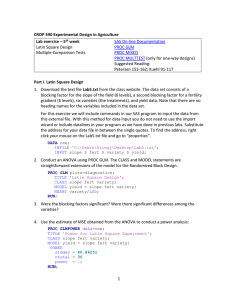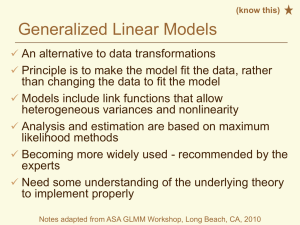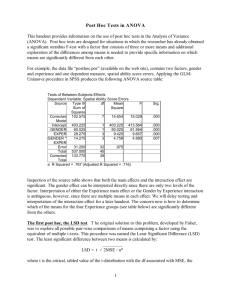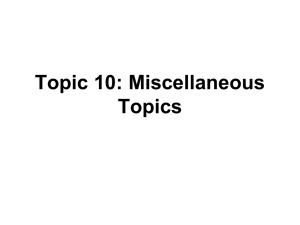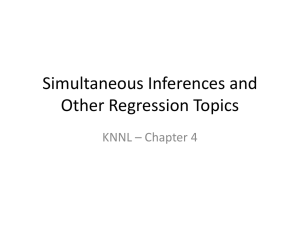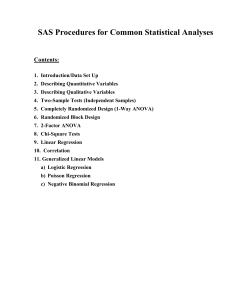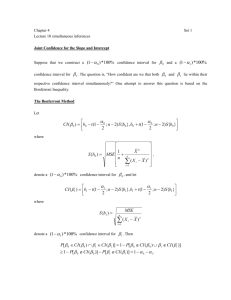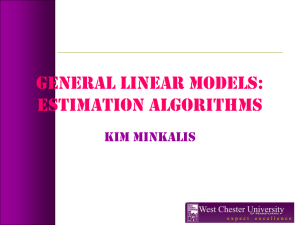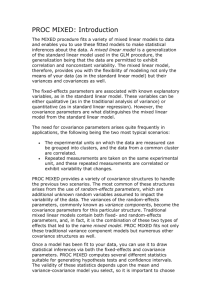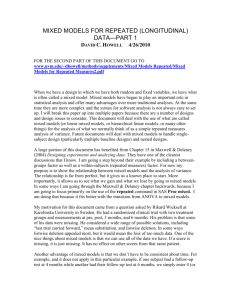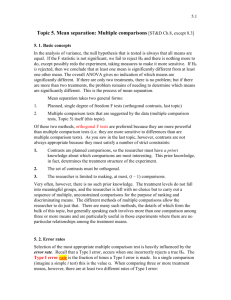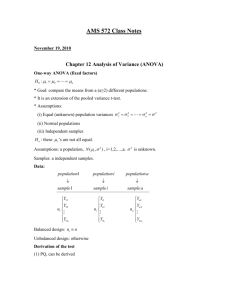Topic_22
advertisement
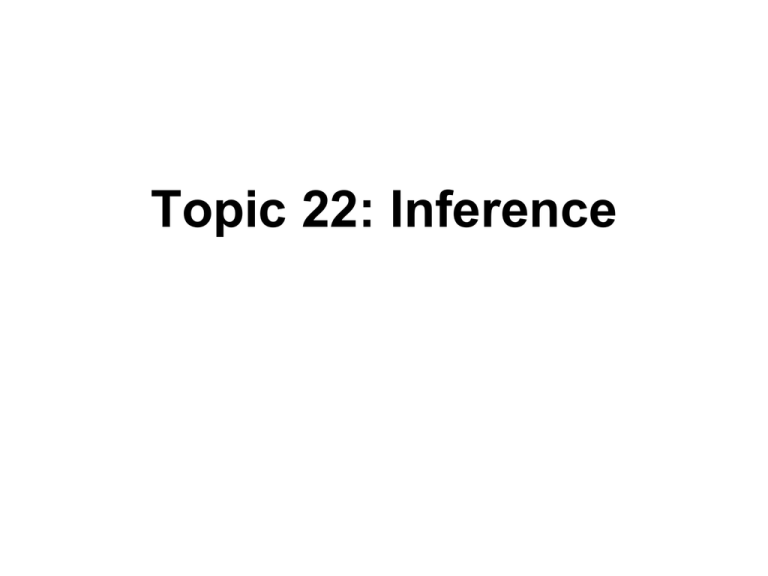
Topic 22: Inference Outline • • • • Review One-way ANOVA Inference for means Differences in cell means Contrasts Cell Means Model • Yij = μi + εij where μi is the theoretical mean or expected value of all observations at level i and the εij are iid N(0, σ2) Yij ~N(μi, σ2) independent Parameters • The parameters of the model are – μ1, μ2, … , μr – σ2 • Estimate μi by the mean of the observations at level i, – ûi = Yi= (ΣYij)/(ni) (level i sample mean) – si2 = Σ(Yij- Yi)2/(ni-1) (level i sample variance) – s2 = Σ(ni-1)si2 / (nT-r) (pooled variance) F test • • • • • • F = MSM/MSE H0: μ1 = μ2 = … = μr = μ H1: not all of the μi are equal Under H0, F ~ F(r-1, nT-r) Reject H0 when F is large Report the P-value KNNL Example • KNNL p 676, p 685 • Y is the number of cases of cereal sold • X is the design of the cereal package – there are 4 levels for X because there are 4 different package designs • i =1 to 4 levels • j =1 to ni stores with design i Plot the means proc means data=a1; var cases; by design; output out=a2 mean=avcases; symbol1 v=circle i=join; proc gplot data=a2; plot avcases*design; run; The means Confidence intervals • • • • Yi ~ N(μi, σ2/ni) CI for μi is Yi ± tc s n i tc is computed from the t(α/2,nT-r) Degrees of freedom larger than ni-1 because we’re pooling variances together into one single estimate • This is advantage of ANOVA if appropriate Using Proc Means proc means data=a1 mean std stderr clm maxdec=2; class design; This does not var cases; use the run; pooled estimate of variance. Output N des Obs 1 5 2 5 3 4 4 5 Mean Std Dev 14.60 2.30 13.40 3.65 19.50 2.65 27.20 3.96 Std Error 1.03 1.63 1.32 1.77 We can use this information to calculate SSE SSE = 4(2.3)2 + 4(3.65)2 + 3(2.65)2 + 4(3.96)2 = 111.37 Confidence Intervals Lower 95% des CL for Mean 1 11.74 2 8.87 3 15.29 4 22.28 Upper 95% CL for Mean 17.46 17.93 23.71 32.12 There is no pooling of error in computing these CIs Each interval assumes different variance estimate CI’s using PROC GLM proc glm class model means run; data=a1; design; cases=design; design/t clm; Output The GLM Procedure t Confidence Intervals for cases Alpha 0.05 Error Degrees of Freedom 15 Error Mean Square 10.54667 Critical Value of t 2.1314 CI Output des 4 3 1 2 N 5 4 5 5 Mean 27.200 19.500 14.600 13.400 95% Confidence Limits 24.104 30.296 16.039 22.961 11.504 17.696 10.304 16.496 These CI’s are often narrower because more degrees of freedom (common variance) Multiplicity Problem • We have constructed 4 (in general, r) 95% confidence intervals • The overall confidence level (all intervals contain its mean) is less that 95% • Many different kinds of adjustments have been proposed • We have previously discussed the Bonferroni (i.e., use α/r) BON option proc glm class model means run; data=a1; design; cases=design; design/bon clm; Output Bonferroni t Confidence Intervals for cases Alpha 0.05 Error Degrees of Freedom 15 Error Mean Square 10.54667 Critical Value of t 2.83663 Note the bigger t* Bonferroni CIs des N 4 3 1 2 5 4 5 5 Simultaneous 95% Mean Confidence Limits 27.200 19.500 14.600 13.400 23.080 14.894 10.480 9.280 31.320 24.106 18.720 17.520 Using LSMEANS • LSMEANS statement provides proper SEs for each individual treatment estimate AND confidence intervals as well lsmeans design / cl; • However, statement does not provide ability to adjust these single mean CIs for multiplicity Hypothesis tests on individual means • Not usually done • Use PROC MEANS options T and PROBT for a test of the null hypothesis H0: μi = 0 • To test H0: μi = c, where c is an arbitrary constant, first use a DATA STEP to subtract c from all observations and then run PROC MEANS options T and PROBT • Can also use GLM’s MEAN statement with CLM option (more df) Differences in means • Yi. Yk. ~ N(μi-μk, σ2/ni + σ2/nk) • CI for μi-μk is Yi. Yk. ± tcs( Yi. Yk.) where s(Yi. Yk. ) =s 1 ni 1 nk Determining tc • We deal with the multiplicity problem by adjusting tc • Many different choices are available – Change α level (e.g., bonferonni) – Use different distribution LSD • • • • Least Significant Difference (LSD) Simply ignores multiplicity issue Uses t(nT-r) to determine critical value Called T or LSD in SAS Bonferroni • Use the error budget idea • There are r(r-1)/2 comparisons among r means • So, replace α by α/(r(r-1)/2) and use t(nT-r) to determine critical value • Called BON in SAS Tukey • Based on the studentized range distribution (maximum minus minimum divided by the standard deviation) • tc = qc/ 2 where qc is detemined from SRD • Details are in KNNL Section 17.5 (p 746) • Called TUKEY in SAS Scheffe • Based on the F distribution • tc = (r - 1)F(1 - α; r - 1, N - r) • Takes care of multiplicity for all linear combinations of means • Protects against data snooping • Called SCHEFFE in SAS • See KNNL Section 17.6 (page 753) Multiple Comparisons • • • • LSD is too liberal (get too many Type I errors) Scheffe is too conservative (very low power) Bonferroni is ok for small r Tukey (HSD) is recommended Example proc glm class model means lsd run; data=a1; design; cases=design; design/ tukey bon scheffe; LSD t Tests (LSD) for cases NOTE: This test controls the Type I comparisonwise error rate, not the experimentwise error rate. Alpha 0.05 Error Degrees of Freedom 15 Error Mean Square 10.54667 Critical Value of t 2.13145 LSD Intervals design Comparison 4 4 4 3 3 3 1 1 1 2 2 2 - 3 1 2 4 1 2 4 3 2 4 3 1 Difference Between Means 7.700 12.600 13.800 -7.700 4.900 6.100 -12.600 -4.900 1.200 -13.800 -6.100 -1.200 Simultaneous 95% Confidence Limits 3.057 8.222 9.422 -12.343 0.257 1.457 -16.978 -9.543 -3.178 -18.178 -10.743 -5.578 12.343 16.978 18.178 -3.057 9.543 10.743 -8.222 -0.257 5.578 -9.422 -1.457 3.178 *** *** *** *** *** *** *** *** *** *** Tukey Tukey's Studentized Range (HSD) Test for cases NOTE: This test controls the Type I experimentwise error rate. Alpha 0.05 Error Degrees of Freedom 15 Error Mean Square 10.54667 Critical Value of Studentized Range 4.07597 4.07/sqrt(2)= 2.88 Tukey Intervals design Comparison 4 4 4 3 3 3 1 1 1 2 2 2 - 3 1 2 4 1 2 4 3 2 4 3 1 Difference Between Means 7.700 12.600 13.800 -7.700 4.900 6.100 -12.600 -4.900 1.200 -13.800 -6.100 -1.200 Simultaneous 95% Confidence Limits 1.421 6.680 7.880 -13.979 -1.379 -0.179 -18.520 -11.179 -4.720 -19.720 -12.379 -7.120 13.979 18.520 19.720 -1.421 11.179 12.379 -6.680 1.379 7.120 -7.880 0.179 4.720 *** *** *** *** *** *** Scheffe Scheffe’s Test for cases NOTE: This test controls the Type I experimentwise error rate, but it generally has a higher Type II error rate than Tukey's for all pairwise comparisons. Alpha 0.05 Error Degrees of Freedom 15 Error Mean Square 10.54667 Critical Value of F 3.28738 Sqrt(3*3.28738)= 3.14 Scheffe Intervals design Comparison 4 4 4 3 3 3 1 1 1 2 2 2 - 3 1 2 4 1 2 4 3 2 4 3 1 Difference Between Means 7.700 12.600 13.800 -7.700 4.900 6.100 -12.600 -4.900 1.200 -13.800 -6.100 -1.200 Simultaneous 95% Confidence Limits 0.859 6.150 7.350 -14.541 -1.941 -0.741 -19.050 -11.741 -5.250 -20.250 -12.941 -7.650 14.541 19.050 20.250 -0.859 11.741 12.941 -6.150 1.941 7.650 -7.350 0.741 5.250 *** *** *** *** *** *** Output (LINES option) Scheffe Mean N design A 27.200 5 4 B B B B B 19.500 4 3 14.600 5 1 13.400 5 2 Using LSMEANS • LSMEANS statement provides proper SEs AND confidence intervals based on multiplicity adjustment lsmeans design / cl adjust=bon; • However, statement does not have lines option • Can use PROC GLIMMIX to do this….approach shown in sasfile Linear Combinations of Means • These combinations should come from research questions, not from an examination of the data • L = Σiciμi ˆ = Σici Y ~ N(L, Var( L ˆ )) • L i ˆ ) = Σici2Var(Y) • Var( L i • Estimated by s2Σi(ci2/ni) Contrasts • • • • • Special case of a linear combination Requires Σici = 0 Example 1: μ1 – μ2 Example 2: μ1 – (μ2 + μ3)/2 Example 3: (μ1 + μ2)/2 - (μ3 + μ4)/2 Contrast and Estimate proc glm data=a1; class design; model cases=design; contrast '1&2 v 3&4' design .5 .5 -.5 -.5; estimate '1&2 v 3&4' design .5 .5 -.5 -.5; run; Output Contr DF SS MS F P 1&2 v 3&4 1 411 411 39.01 <.0001 Par Est 1&2 v 3& -9.35 St Err t P 1.49 -6.25 <.0001 Contrast performs F test. Estimate performs t-test and gives estimate. Multiple contrasts • We can simultaneously test a collection of contrasts (1 df each contrast) • Example 1, H0: μ2 = μ3 = μ4 • The F statistic for this test will have an F(2, nT-r) distribution • Example 2, H0: μ1 = (μ2 + μ3 + μ4)/3 • The F statistic for this test will have an F(1, nT-r) distribution Example proc glm data=a1; class design; model cases=design; contrast '1 v 2&3&4' design 1 -.3333 -.3333 -.3333; estimate '1 v 2&3&4' design 3 -1 -1 -1 /divisor=3; contrast '2 v 3 v 4' design 0 1 -1 0, design 0 0 1 -1; Output Con DF 1 v 2&3&4 1 2 v 3 v 4 2 F 10.29 22.66 P 0.0059 <.0001 St Par Est Err t P 1 v 2&3&4 -5.43 1.69 -3.21 0.0059 Last slide • We did large part of Chapter 17 • We used programs topic22.sas to generate the output for today
